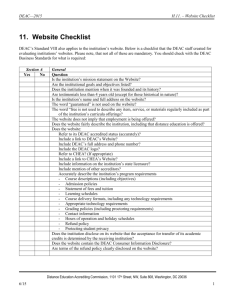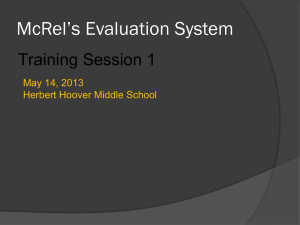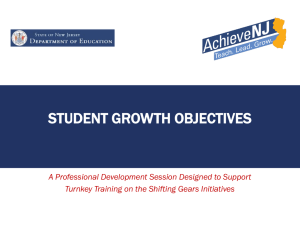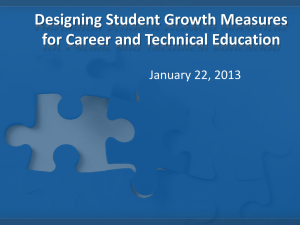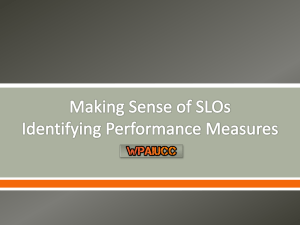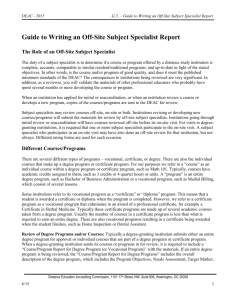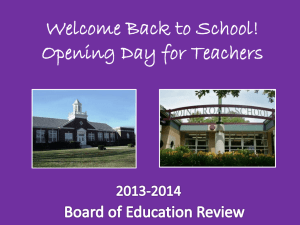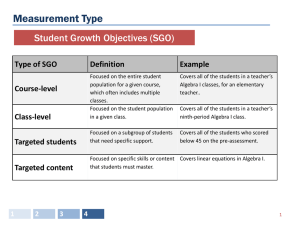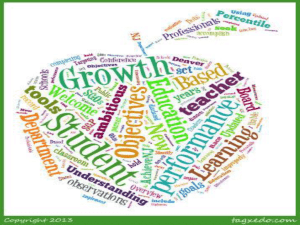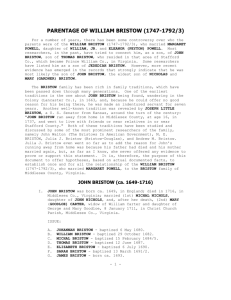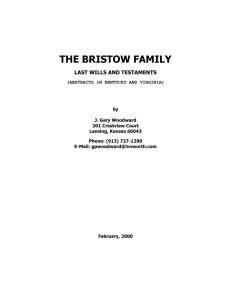DEAC Presentation Apriil 23, 2013
advertisement
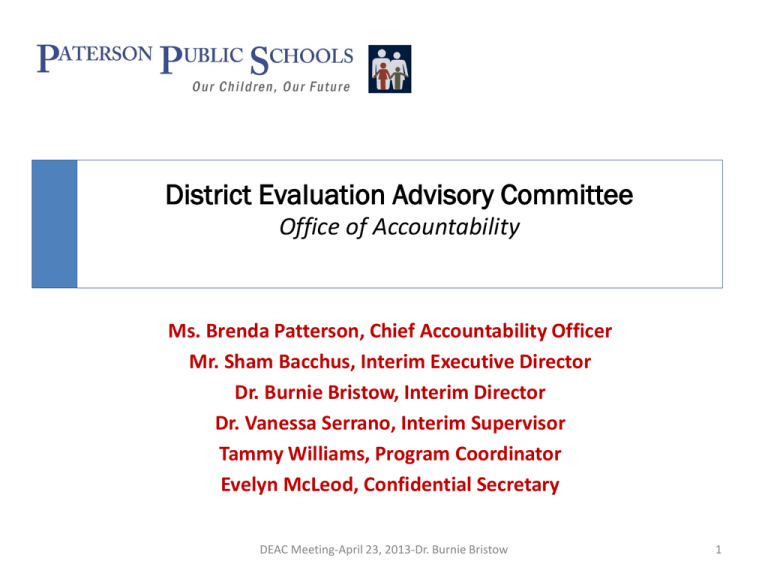
District Evaluation Advisory Committee Office of Accountability Ms. Brenda Patterson, Chief Accountability Officer Mr. Sham Bacchus, Interim Executive Director Dr. Burnie Bristow, Interim Director Dr. Vanessa Serrano, Interim Supervisor Tammy Williams, Program Coordinator Evelyn McLeod, Confidential Secretary DEAC Meeting-April 23, 2013-Dr. Burnie Bristow 1 Welcome District Evaluation Advisory Committee DEAC Meeting-April 23, 2013-Dr. Burnie Bristow 2 AGENDA Office of Accountability DEAC Committee Meeting April 23, 2013 90 Delaware Avenue Facilitator: Dr. Burnie Bristow, NBCT Cafeteria, 2:30-4:30 pm Thoroughly Trained 2:30-2:40 Meet and Greet 2:40-2:50 Revisit Roles and Responsibilities of the DEAC Committee 2:50-3:05 Steering Committee Updates Sub-Committee Student Information System 3:05 AchieveNJ Updates 3:05-3:20 Non-Tested Grades and Subjects Developing Student Growth Objectives (Teacher Focus) 3:20-3:35 Tested Grades and Subjects Student Growth Percentiles (Teacher Focus) Developing Student Growth Objectives (Teacher Focus) 3:35-3:40 Summer Professional Development Opportunities for Teachers 3:40-4:00 Exemplary Teacher Training -Dave Roudebush, Ph.D., Curriculum Focal Point 4:00-4:25 How will the Paterson Public School District define “THOROUGHLY TRAINED”? 4:25-4:30 Action Items: Next steps Deliverables Next meeting date DEAC Meeting-April 23, 2013-Dr. Burnie Bristow 3 Roles and Responsibilities of the DEAC Committee The DEAC committee (formed Dec. 2011) functions as an advisor to the Paterson Public Schools in the implementation of the TEACH NJ Act. Embedded in the TEACHNJ Act is a requirement to revise the Principal and Teacher Evaluation System. Membership on the DEAC Committee provides an opportunity for committee members to provide feedback on the performance rubrics, program development and implementation at the school and community level. The DEAC committee is comprised of teachers, principals, central office staff, school board members and parents. DEAC Meeting-April 23, 2013-Dr. Burnie Bristow 4 Teacher Effectiveness and Accountability for the Children of New Jersey (TEACHNJ) Act.” The goal of this legislation is to raise student achievement by improving instruction through the adoption of evaluations that provide specific feedback to educators, inform the provision of aligned professional development, and inform personnel decisions; DEAC Meeting-April 23, 2013-Dr. Burnie Bristow 5 Update on the Student Information System Sham Bacchus DEAC Meeting-April 23, 2013-Dr. Burnie Bristow 6 Current Data Sources/Systems that directly impact new Evaluation Instrument Student Achievement Data Student Information Staff Information Financial Communication/ Technology Performance Matters Fusion/Keystone Edumet Edumet Email Renaissance Learning Genesis (Eastside/JFK) Kronos Alio Active Directory Scholastic/ Pearson EasyIEP Applitrack NJSMART Class Gradebooks ParentLink PDPro McRel Currently requires human input from schools and central office. (Error Laden) - 17 Currently gets data from other systems. (Preferred) - 5 Teachscape* 7 Brenda Patterson, Chief Accountability Officer, PPS Data Integration There was a need for an internal review of the programs, processes and technical components required to effectively support the implementation of the new Principal and Teacher Evaluation. This review of our infrastructure necessitated a cross departmental collaboration to integrate various systems. DEAC Meeting-April 23, 2013-Dr. Burnie Bristow 8 9 Communications, Business, HR Assessment, MIS, Technology Merging platform ALIO and MIS Support to assessment Develop data platform to record and keep track of teacher and school achievement data Teacher E-board / blog /Dropbox Collaborative Teams as Decision Makers: Communications/Technology/MIS, Business, Reform - Assessment/HR/PD, C & I, Special Programs and Accountability STUDENT GROWTH OBJECTIVES Introduction to the Guidebook w/ Sham Bacchus April, 2013 Charlotte –Mecklenburg SLO study Key findings: • The higher the quality of the SLO, the more likely it is to be attained • The quality of SLOs increases significantly in just two years • Students whose teachers had higher quality SLOs achieve higher scores on math and ELA tests • Students whose teachers met their SLOs achieve higher scores on math and ELA tests 11 Charlotte –Mecklenburg SLO study What principals said about SLOs “The way of doing business in the school is the SLO process. It adds to the spirit of cooperation.” “Developing SLOs forces teachers to target low performing kids and then work harder to pull those kids up.” “We have moved from a priority school to a high growth school, and I give a lot of credit for this change to the SLO process.” 12 Charlotte –Mecklenburg SLO study What mattered most in the SLO process 1) Analyze student baseline data, for use in planning and teaching 2) Set individual student growth targets, for both more informative and accurate assessment of student learning 3) Participate in collegial collaboration in the development of SLOs 13 Shift in Practice Student Growth Objectives Brenda Patterson, Chief Accountability Officer, PPS DEAC Meeting-April 23, 2013-Dr. Burnie Bristow 14 What is an SGO? A Student Growth Objective is a long-term academic goal that teachers set for groups of students and must be: • • • • • Specific and measureable Aligned to New Jersey’s curriculum standards Based on available prior student learning data A measure of student learning between two points in time Ambitious and achievable Page 3 15 NTGS 101: Student Growth Objective Overview Different types of Student Growth Objectives: Student Growth Objectives can take many different forms Type of SGO Definition Examples Class-level Focused on the entire student population for a given course, which often includes multiple classes. Focused on the student population in a given class. Covers all of the students in a teacher’s Algebra I classes (Ideally the same form of assessment covering all standards in the curriculum) Covers all of the students in ninth period. Targeted students Focused on a subgroup of students that need specific support. Covers a group of students that scored below 45% on the pre-test. Course-level Targeted content Focused on specific skills or content Students will all master 80% of CCSS that students must master. standards related to Quadratic Functions and Modeling 17 17 17 NTGS 101: Specific Student Growth Objective Specific Objective: Examples The word “specific objective” would likely be used to identify anything that does not cover your general population or is not a cumulative test Type Student Growth Objective Targeted students The average score on the post-test for the ten ELL students who scored below 40% on the pre-test will be at least 70%. Targeted standard The average student score on questions related to Standard 5.1.12.B (scientific thinking and design) will increase from 40% to 80%. 18 18 18 SGOs in Achieve NJ - requirements • A teacher develops SGOs in consultation with his or her principal. • All teachers who receive an SGP score must set between 1 and 2 SGOs. • Teachers who do not receive an SGP score must set 2 SGOs. • SGOs must be aligned to NJCCCS or CCSS and measure student achievement and/or growth. • SGOs must be specific and measurable and based on available student learning data. 20 NTGS 101: Pilot Districts Student Achievement Goals (SAGs): Pilot Districts were given the recommendation to use SAGs for the 2012 – 2013 school year DEAC Meeting-April 23, 23 23 NTGS 101: SGO – a high school biology example SGO Components: General Timeline August Assessment Baseline Data • Administer department developed pre-test aligned with 2009 CCCS • • Determine general preparation level . Group students into three categories (low, medium, high). Determine specific areas of deficit . • • Growth Objectives • General – set an objective for all students at each preparation level covering all content. Specific – set an objective for all students to grow in a particular content standard. November 26 26 NTGS 101: SGO – a high school biology example SGO Components: General Timeline January Monitor and Adjust • Use benchmark assessments to monitor progress and adjust instruction. • Administer department-developed standards-based post-test at the end of the year and analyze data. • Determine to what degree growth objective was met and produce a summative rating. Measure Evaluate June 27 27 Teacher Evaluation: Summative Rating Timeline • At summative conference, all available component scores (i.e. teacher practice, SGO results) will be discussed. • SGP data will be available on the following timeline. November/December NJASK scores released. Department calculates SGP data and sends to districts the SGP and summative ratings of each teacher with a SGP score. June Annual summary conference includes: Available component measures. October Department collects all other component measures for teachers with SGP. Teacher Practice Student Growth Percentile Student Growth Objective Sum. Rating January Summative rating added to personnel file. 28 28 5 Steps • Step 1: Choose or develop a quality assessment aligned to NJCCCS or CCSS. • Step 2: Determine students’ starting points. • Step 3: Set ambitious and achievable SGOs with the approval of the principal/supervisor. • Step 4: Track progress, refine instruction. • Step 5: Review results and score in consultation with your principal/supervisor. Page 8 – Quick Start Guide 31 Traditional Assessments • National/State tests (e.g., Advanced Placement exams, DIBELS, EOC Biology test) • District, school and departmental tests (e.g., final exams) Portfolio Assessments Performance Assessment • Teaching Strategies Gold® (pre-K, K) • Writing and reflection samples (LAL) • Laboratory research notebook (sciences) • Portfolio of student work (visual and performing arts, etc.) • Student project-based assessments (all subjects) • Lab Practicum (sciences) • Sight reading (music) • Dramatic performance (drama) • Skills demonstration (physical education) • Persuasive speech (public speaking) Page 10 32 • Develop assessments collaboratively. • Align all assessments with NJCCCS or CCSS. • Align all assessments with district, school and department goals. • Make sure all the content in your SGO is covered in the assessment. • Incorporate test items that vary in levels of difficulty. • Include a sufficient number of test items to ensure rigor. • Collaboratively determine possible modifications to meet the needs of students. • Develop rubrics to assess essay responses. • Make sure content- and skill-based rubrics are specific and address multiple levels of proficiency. Page 11 33 Page 26 34 Page 27 35 Page 28 36 Source of Performance Data to Determine Students’ Starting Points Examples and Notes Results from beginning-of-course diagnostic tests or performance tasks Department-generated pre-assessment Early course test Results from prior-year tests that assess knowledge and skills that are pre-requisites to the current subject/grade Results from tests in other subjects including both teacher- or school-generated tests and state tests (tests must have assessed prerequisite knowledge and skills) Students’ grades in previous classes NJASK for math, LAL and science DRA for reading End of course tests assessments, e.g. results on English 9 writing portfolio are used by the English 10 teacher A physics teacher uses results of her students’ prior math assessments Page 13 Teachers should make sure they understand the basis for the grades given by students’ previous teachers 37 SGO Guidebook Development Continuous improvement with information from the field – Modification and addition of forms – Clarity of language – Models of SGOs – More guidance on assessments, including portfolios 43 Summer Professional Development Dr. Vanessa Serrano 44 44 Principal and Teacher Evaluation System Training Discussion Dr. Dave Roudebush, Focal Point April 23, 2013 Teacher Evaluation System • Performance Standard #1: Preparation for Instruction – Establishing a culture of high expectations for learning and achievement – Uses district adopted curriculum and content knowledge to design coherent lessons – Post aligned lesson objectives and plan for demonstration of learning 46 Teacher Evaluation System • Performance Standard #2: Use of Data to Inform Instruction – Focus on improving instruction using data – Use a variety of assessment methods when designing classroom assessments – Involve students in assessing their own learning 47 Teacher Evaluation System • Performance Standard #3: Delivers Quality Instruction – Instruct bell to bell – Use a variety of instructional strategies to focus instruction – Engages students in learning – Continually checks for understanding – Deliver rigorous and relevant content – Integrate 21st Century Skills in instruction – Provides feedback about student proficiency 48 Teacher Evaluation System • Performance Standard #4: Interventions to Meet Diverse Needs – Differentiate instruction based on student needs and background – Implements interventions with fidelity and adjusts interventions based on results – Adapt and modify instruction for the unique needs of learners 49 Teacher Evaluation System • Performance Standard #5: Classroom Environment – Contribute to a safe and orderly learning environment – Use effective classroom management procedures – Effectively manage student behavior – Foster collaboration and self-regulation in students – Promote positive and respectful rapport 50 Teacher Evaluation System • Performance Standard #6: Leadership – Understand their role and responsibility for professional growth and positive leadership – Promote the concept of Professional Learning Communities through collaboration and purposeful involvement – Continue professional growth 51 Teacher Evaluation System • Performance Standard #7: Professional Responsibilities – Adhere to Federal laws, state statutes and regulation pertaining to education, Board of Education policies, Memoranda of Understanding and school rules – Demonstrates professionalism – Effectively communicates and solves problems 52 Teacher Evaluation System Professional Development Opportunities • Two Major Professional Development Strands – Curriculum Alignment/Instructional Strategies – The Teacher Evaluation Performance Rubric 53 Professional Development Opportunities • Aug. 18-19, 2011 * Aug. 25-27, 2011 • Sep. 19-21, 2011 * Oct. 8, 2011 • Aug. 21-30, 2012 * Sep. 4-5, 2012 • Oct. 12, 2012 * Feb. 15, 2013 To Date 2,300 teachers have been trained Approximately 202 teachers need to be trained 54 Thoroughly Train Teachers: Stop. Reflect and Discuss: Think about what you have seen presented here, How will the Paterson Public School District define “THOROUGHLY TRAINED”? Please write down and discuss your thoughts and ideas at your table. Please be prepared to share your most salient ideas with the committee. DEAC Meeting-April 23, 2013-Dr. Burnie Bristow 55 Next Steps DEAC Meeting-April 23, 2013-Dr. Burnie Bristow 56 THANK-YOU DEAC Meeting-April 23, 2013-Dr. Burnie Bristow 57
